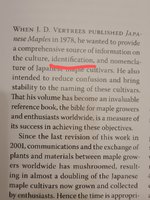Canada Bonsai
Chumono
- Messages
- 653
- Reaction score
- 2,265
I wish people would stop guessing at Japanese maple cultivars when the tree might not even be a cultivar.
Thank you for doing this, and it does needs to be said over and over again
People taking guesses has caused a lot of confusion for quite a few cultivars. Deshojo is a very good example: in North America there are currently at least 5-6 strains circulating as 'Deshojo/Shin Deshojo' that were so-named 'because they look a lot like Deshojo' under certain conditions. It is sometimes possible to follow the supply chain and track down the source of these issues, but once the problem is out in the wild it is almost impossible to resolve (esp. because there is so much sharing and home-propagation in the world of Japanese Maples).
Similar troubles occur with transcribing and/or translating Japanese-named cultivars; the lowest-level of this gets as simple-minded as people arguing--and producing pictures to support their arguments--over whether Shishigashira or Shishi Gashira is the nicer cultivar...

